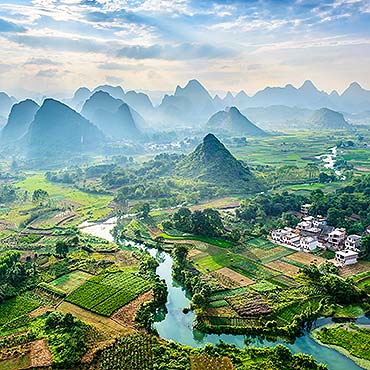
The ultimate bucket list of best places to visit in China would be as unwieldy as a Chinese New Year dragon if it wasn’t for the input and help from our ever reliable team of travel consultants and guides.
Even while international travel remains on hold, we sense the travel dreams for many of our customers are bubbling away. And with so much time to plan and scheme, why not? In fact, now is the perfect time to design a tour that includes the best places to visit.
After all, how many times have you found yourself on a tour and wondered why you’ve been taken to a certain destination or highlight? Even if it’s only been once, we figure it’s one time too many – so we’ve come up with this list: Best places to visit in China.
It’s been designed with the savvy western traveler in mind.
You won’t find sights and highlights that leave you wanting more. No, instead, you’ll have the ultimate list of best places to visit in China, allowing you to travel virtually right now in preparation for the real thing when borders reopen.
Ready? Let’s go!
Beijing

Beijing is a must-visit destination on any first time tour to China and with this city of power, politics, and ceremony comes a ‘best of’ selection of iconic China highlights.
#1 The Great Wall
It’s virtually impossible to separate China from its most well-known landmark, the Great Wall. Stretching more than 20,000 kilometres west of the mountain ridges north of Beijing, travelers can access this UNESCO World Heritage listed highlight from many locations. Our preference is for the Mutianyu section of the wall because it is less frequented than other sites close to Beijing (it’s an easy 90 minute drive away). The Mutianyu section of the wall is unique for its military watchtowers, which provide travellers with incredible views across the mountains outside Beijing, just as it did for soldiers and sentinels in centuries past.
As wonderful as Mutianyu is, there is more to the Great Wall and we love introducing other sections to our customers. If adventure is your thing, then consider a hiking tour. Maybe you’re a photographer and looking for the ultimate in lasting travel memories. Then consider visiting the Jinshanling and Simatai sections with its steep ridges and endless views. Regardless of what you’re looking for, we can create exactly what you’re looking for.
#2 Forbidden City
Standing as a remarkable example of design, engineering, and planning, the Forbidden City is truly ‘something else’. Located at the heart of Beijing, this centuries old imperial palace from the Ming and Qing dynasties is an amazing demonstration of Chinese royal architecture. Without doubt, it is the best place for gaining an insight to imperial culture and the glorious court life of feudal society in China. It now serves as home to the Beijing Palace Museum, where a collection of over one million pieces of precious relics is housed.
#3 Temple of Heaven
Covering an area four times the size of the Forbidden City, the Temple of Heaven was a royal site used by emperors to worship heaven in the hope that it would bring a good harvest and prosperity for the country. You will marvel at the deep thought, design, and symbolism which are a feature of the whole area that makes up the Temple of Heaven. Balance and symmetry reign supreme here, leaving you in no doubt as to the brilliance of those behind its construction. Enjoy the surrounding parklands, where you’ll discover other buildings and age-old cypress trees. A stand-out highlight here is the rebuilt Hall of Prayer for Good Harvests, which was built using the ancient – but highly sophisticated – method of mortise and tenon joints in which no nails are used. First erected in 1420, a fire that razed it to the ground in 1889 meant reconstruction was necessary.
#4 Summer Palace
More imperial grandeur is to be found at The Summer Palace, located about 15 kilometres northwest of Beijing’s city centre. The Summer Palace has a well-earned reputation as the largest and best-preserved imperial garden in China, and is rightly listed as a World Heritage Site by UNESCO. First built in 1153, the palace garden was the summer retreat for emperors, concubines and, most notably, the Empress Dowager Cixi, who ruled China for some 47 years. After extensive restoration and reconstruction, the garden, palaces, temples, corridors and exquisite exhibits can be seen reflecting their former glory against the backdrop of an incredible man-made lake.
Xi’an

There’s no doubt China’s history is characterized by the rise and fall of many dynasties and that warriors take pride of place in the country’s rich history. When you visit Xi’an, you’ll come face to face with the famous Terracotta Army; a reflection of a unique vision held by Emperor Qin for his protection in the afterlife. Xi’an exudes ‘personality’ and you’ll see why when you travel to the city’s heart and scale its beautifully restored City Wall, which offers vistas of a place that has been the historical launchpad for China’s Silk Road.
#1 Terracotta Army
It seems everything in ancient China was done on a grand scale, and the Terracotta Army is no exception. Discovered in 1974 by a humble local farmer near the Mausoleum of the First Qin Emperor – Qin Shi Huang – the Terracotta Army is an amazing collection of life size terracotta figures, horses, and chariots, which are believed to be part of Emperor Qin’s attempt to protect himself in the afterlife. Incredibly, there is still more to be excavated at the site and restorations are ongoing within the onsite ‘hospital’ for damaged soldiers and horses.
#2 Xi’an City Wall
Explore Xi’an’s City Wall, believed to be China’s largest and best-preserved; no mean feat given the number of ancient city walls. Enclosing China’s former capital city, and almost 14 kilometres long, tap into your inner child and enjoy riding the full circuit on a bike (there are tandems available!) or simply explore on foot, taking time to peek out through the wall as guards did in the past and gain a bird’s eye view of this lively, colorful city. Marvel at city gates that can be found on each side of the wall. Four of these are the main gates (north, south, east, and west). Each is beautifully decorated, especially the south gate, while the gates’ design as complex and robust fortifications, meant attackers would find it difficult to break through. As with many attractions in China, the Xi’an City Wall is a testament to the ingenuity, foresight, and creativity of its leaders and engineers.
Shanghai

Shanghai really is unlike any other destination in China. Of course, you’ll find the rich history that is ubiquitous throughout all China, however, Shanghai’s unique appeal is found in the way the ancient entwines with the contemporary, a reflection of colonial conquest, commerce, and international influences. The magnificent Huangpu River has been – and remains – the city’s life force making it a central feature of any visit, however if you see nothing else, be sure to spend time walking The Bund and visiting Yuyuan Garden and Bazaar.
#1 The Bund
Located in the Huangpu District of Shanghai on the bank of the Huangpu River, The Bund is perhaps the most impressive promenade in Shanghai. Apart from providing a present day glimpse into Shanghai’s glamorous early 20th century commercial past (the Bund is a legacy of stunning 1920’s architecture and design), it offers the perfect view of a more contemporary skyline punctuated by sky-high buildings like the Oriental Pearl Television Tower and the Jin Mao Tower across the river in Pudong. Explore by day or night and enjoy the vibe created by the fabulous boutiques, restaurants, bars, and people who carry forward the energy of Shanghai today.
#2 Yuyuan Garden and Bazaar
Once the residence of a prestigious local merchant family prominent during the Ming dynasty, Yuyuan Garden reflects the thoughtful and considered art of garden design so much a part of Chinese culture. Multi-layered with exquisite examples of garden design and beautifully maintained, despite being destroyed not once, but twice in its long history, Yuyuan is the ideal place to wander in contemplation and capture beautiful images. By total contrast, visit the nearby Bazaar for an experience of browsing through a market with locals. Expect to find just about anything and maybe even make a purchase or two.
Chengdu

The capital of land-locked Sichuan Province in China’s southwest, Chengdu has a well-earned reputation for its relaxed lifestyle, slower pace, and of course, for its most famous residents, the world’s largest population of giant pandas. However, there is more to this city: famous spicy Sichuan hotpots, Tibetan influences, melodramatic Chinese opera, magical Bian Lian (mask changing), and a devoted tea culture. Discover it all with just a couple of days visiting this fascinating city.
#1 Giant Panda Breeding Research Base
Nowhere else in the world can you gain such a complete appreciation of these amazing wonders of nature, giant pandas, and record your experience with them in photographs. The Giant Panda Breeding Research Base is perhaps the most popular of all places where pandas can be seen. They live, eat, and love in well maintained enclosures, and if you’re very lucky, your visit may be timed with the arrival of the baby pandas, which win all awards for total cuteness. The Research Base provides insights to the breeding program, delivery room, and anything panda related. Whether they’re the live version, or stuffed, cuddly take-home type, the giant pandas will inevitably steal your heart.
Guilin

Guilin sits against a backdrop of some of China’s finest and most famous natural landscapes and scenery. It is also home to local sites, the Elephant Trunk Hill, Seven Star Park, and the stunning Reed Flute Cave, with its incredible naturally formed stalagmites and stalactites formed over 180 million years ago. Once you’ve made your way around the local highlights, complete your time in Guilin with a leisurely cruise along the Li River to Yangshuo. It’s the perfect way to relax into the slower pace to be found here.
#1 Li River
Be inspired as poets and ancient Chinese leaders have by the instantly recognizable karst stone mountain landscape and water buffaloes that line the Li River. While the river itself may be with cruise boats and traditional rafts, a Li River cruise is the ideal opportunity to relax and absorb the scenery en route to Yangshuo. Expect to take a multitude of photos of the instantly recognizable scenery for which this region is famous.
#2 Yangshuo
In less than two decades Yangshuo has grown from a tiny ancient village to a bustling modern town catering to international visitors. In Yangshuo, appreciate the local traditional ethnic culture with a 1400 year history. There is much to absorb in the amazing scenery around this ‘town’ and amidst the blend of local and western cultures and cuisines in West Street with its vibrant shops and restaurants. Yangshuo offers an insight to an authentic rural landscape, punctuated by small local farms, winding roads, and a slower pace not found in China’s big cities.
Dunhuang

An important stop for camel caravans traveling the Silk Road, it’s easy to see how Dunhuang became home to rich historical relics and religious arts. Dunhuang allows you to delve into exquisite murals and sculptures in the Mogao Caves, which are over a thousand years old. It is also renowned for its location in an oasis where you’ll find Crescent Spring and Echoing Sands Dune. Ready to take a step back in time? Then Dunhuang is one of the best place to visit in China.
#1 Mogao Caves (Grottoes)
Boasting over 700 caves, 2,000 painted statues, and 40 thousand square meters of mural paintings, the Mogao Grottoes are spectacular on another level. Frequently referred to as the Thousand Buddha Grottoes or Caves of the Thousand Buddhas, the thousands of carvings found here have survived centuries – a marvel in itself – and a visit will inspire awe and wonder.
Lhasa

Remote, mysterious, exotic, and breathtakingly beautiful, Tibet’s capital, Lhasa, is a travel destination beyond compare. Surrounded by mighty ice-capped mountains, awe-inspiring lakes, unique and ancient culture, and friendly people, getting there is worth every step of the distance and time it takes.
#1 Potala Palace
A magnificent icon of Tibet, visiting Potala Palace will be a travel memory you’ll always treasure. Apart from its status as a surprising exemplar of architectural design, Potala Palace is a place where reverence meets wonder. Both pilgrims and travelers alike sense how special it is, regardless of their origins. Formerly the residence of the Dalai Lama, you’ll discover the history behind this sacred, mysterious palace, which dates back to the 7th century. There’s no question about its inclusion on the list of best places to visit in China.
Zhangjiajie

Explore Zhangjiajie and be captivated by the breathtaking sandstone landforms that inspired poets and philosophers long before Avatar became a film that unveiled this gorgeous secret to the world. The city of Zhangjiajie is located in Hunan in China’s southern central region. Its remoteness has preserved both the idyllic landscape and minority peoples who have been its inhabitants for millennia – the Tujia, Miao, and Bai. Rich in diversity – thanks in part to the subtropical and temperate conditions, Zhangjiajie, and the now famous Wulingyuan Scenic Area, are places that regularly make it to the bucket list of China tour travelers.
#1 Zhangjiajie National Forest Park
The Zhangjiajie National Forest Park has more going for it than inspiration for movie backdrops. Stunningly beautiful natural landscapes that literally take your breath away are a welcome contrast from the otherwise busy pace of China’s big cities. A definite inclusion on any ‘must see in China’ list.
#2 Tianzi Mountain Nature Reserve
Rising one after another, the peaks of Tianzi Mountain provide stunning views. Visitors can see the full expanse of the Wulingyuan Scenic Area and the beauty of each season – all at the same time. This unforgettable highlight of our Zhangjiajie tours is where you experience the four wonders: Radiance of the Moonlight, Sea of Clouds, Rays of Sunshine and Snow in Winter. If it’s truly mesmerizing that you’re after, you’ll find it here.
Hangzhou

Hangzhou is the picturesque capital of the Zhejiang province, located on China’s east coast and in proximity to Shanghai. For travelers wanting the opportunity to experience all this city has to offer, one of our Hangzhou tours offers the ideal way to see a different side of China.
For millennia favored by locals for its quintessentially Chinese scenery of wispy willows and green mist covered hills, the city’s major landmark, the West Lake makes it a memorable travel destination. Easily reached by train and plane from Shanghai and Suzhou, join us on one of our Hangzhou tours and experience a laidback and unassuming real experience of China.
#1 West Lake
On West Lake, make the most of a unique opportunity to relax and enjoy the experience of getting out on the water. While you’re in the neighborhood, take time to observe the famous Red Carp Pond. West Lake affords a different perspective of the serenity provided by the natural scenery, historic pagodas, and stunning pavilions that form part of the surrounds. Scenes that conjure up images portrayed by scholars and philosophers are inspired by spots along the way: the poetically named Three Pools Mirroring the Moon and Su Causeway.
Suzhou

Once dubbed the ‘Oriental Venice’, China’s waterside city of Suzhou is admired for its crisscrossing canals, stone bridges, enchanting classical gardens, and relaxed and easy lifestyle. Among Suzhou’s highlights is the Humble Administrator’s Garden and Garden of the Master of Nets, both fine examples of classical Chinese garden design.
#1 Classical gardens
In Suzhou, enjoy the opportunity to explore and admire the exquisite classical gardens. Remarkable creativity, thoughtfulness and design as only ancient Chinese craftsmen can do, is to be discovered at the Humble Administrator’s Garden. So well regarded is it that UNESCO saw fit to make it a World Heritage site. Picturesque landscape harmonizes the many elements of traditional architecture, hills, lawns, flowers, and meandering streams. In the same vein, discover what inspired China’s ancient philosophers, poets, and intellectuals at Master of the Nets Garden. This wondrous garden synthesizes residences and buildings with lakes, grottoes, gardens of flowers and ancient trees. For a unique and altogether different insight to China, Suzhou’s gardens should find their way onto your list.
Hong Kong

If you’ve never even visited, or only ever skimmed through,a Hong Kong travel getaway is like no other. At the intersection of east and west, Hong Kong is a special gateway to bucket list highlights, fabulous food, and yes, even shopping that is matched in few other places around the world. With dizzyingly high skylines, a tropical vibe, and an edgy and modern approach to life, Hong Kong stands out as a China destination for stunning views, gardens and skylines that inspire traditional and modern architecture, and an aliveness that is unique among China’s capitals.
#1 Victoria Peak & The Peak Tram
It may not be Everest, but when you visit Victoria Peak, the highest point in Hong Kong Island, you’ll enjoy incredible panoramic views of the whole city. Look out above the highrises and skyscrapers to the harbor and beyond. And a bonus? Ride aboard the Peak Tram and enjoy the view from the Sky Terrace at the top.
#2 Po Lin Monastery & The Big Buddha
Relatively young by China’s standards, Po Lin Monastery is a Buddhist monastery that was originally known as ‘Big Thatched Hut’ when it was first established on Lantau Island over 100 years ago. The monastery is a place of tranquility and serenity, while the monks who live there – remain committed to creating a place where they can practise and spread Dharma. The Big Buddha Statue – also known as the Tian Tan Buddha – sits at the front of the monastery. It is the second largest outdoor Buddha statue in the world. At 34 meters in height and weighing just over 200 tonnes, locals and visitors alike visit here in reverence – and we feel sure you will too.
Huangshan

There are few natural destinations in China that are as captivating and exquisitely beautiful as Huangshan and the surrounding region. With good reason, Chinese artists and philosophers for centuries retreated to Mount Huangshan – which translates as Yellow Mountain – drawing inspiration from the tranquility created by steep granite mountain peaks, mist covered pine trees and eternal views. You can experience this too when you make it your launchpad for taking in the rich treasures, architecture and natural beauty of nearby villages, Tunxi, Hongcun, and Xidi. Best visited in the autumn from September to October, one of the main highlights is, of course, Mount Huangshan itself.
#1 Mount Huangshan
Whether viewing spectacular scenery from the peaks of “Yellow Mountain” as it pierces the mystical mists or as it sparkles in bright light, you’ll appreciate why this is one of China’s sacred mountains, especially when seen up close on an awe-inspiring hike. Enjoy a cable car ride up the mountain and along the way, savor the beautiful views that take in the surrounding mountains. Once at the top, hike to gorgeous Begin-to-Believe Peak, one of the numerous small peaks that comprise the Huangshan mountain range. It’s the perfect way to absorb the breathtaking views from key vantage points, with Black Tiger Pine and Flower Blooming on a Brush Tip. With beauty inspired names like these, it’s impossible not to be impressed.
The Yangtze River

The Yangtze River is China’s longest river, winding 6,300 kilometers west to east across the country and a Yangtze River cruise is the perfect way to slow down for a few (or more!) days in between other travel activities and destinations in China.
#1 Yangtze River Cruise & Three Gorges
The most popular section of the Yangtze River to take a cruise is known as Three Gorges. Climb aboard one of the many tastefully appointed river boats that take you away from the hustle of China’s big cities, giving you time to soak in the spectacular scenery and awe-inspiring landscapes. Experiencing the Yangtze – in all its magnitude, history and the surrounding natural beauty of jaw-dropping gorges is a once in a lifetime experience, so be sure this adventure makes it to your list of best places to visit in China.
Whether you’re a savvy traveler or a first time visitor to China, doing your research is the best way to make the most of your vacation. Don’t leave the decision about the best places to visit in China to chance. Get help from people who know – and truly care about your experience. Talk to the ChinaTours.com team. We’re travelers too, and we’re committed to helping you create beautiful travel memories that endure long after you’ve arrived home. We welcome online enquiries via direct contact, with responses delivered within 24 hours.




 Great tour with Linda in Beijing
Great tour with Linda in Beijing





